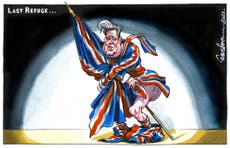What not to wear: A dress code for Westminster politicians
Sean O'Grady takes a look at what is and isn’t considered acceptable by our elected officials


What do we want politicians to look like? What do they think they should look like?
The two are not always identical. Take Rawiri Waititi, member of the New Zealand parliament and who has received global attention for not wearing a tie in the chamber, and being kicked out as a result. Waititi was in fact wearing a different type of neckwear, a traditional Maori hei-tiki, a pendant, and he looked perfectly smart. The speaker in Wellington has now reversed the hasty judgement, but not before some outcry and Waititi describing the traditional western necktie as a “colonial noose”.
Parliaments, like other workplaces around the world, have to move with the times, and politicians find it more difficult than most to get the balance between being elegant and “in touch” exactly right. The anachronistic example of Jacob Rees-Mogg makes the point perfectly. The combination of lanky build, old-fashioned manners (in all senses), and a taste for pinstriped double-breasted suits teamed with pebble spectacles make him look like a character from an Ealing comedy. Some might say that the overall effect is neither elegant nor in-touch, but it has served him well and has proved no impediment to getting elected in Somerset.
Recently, the Labour Party urged its elected representatives to “dress smart”, though there isn’t that much evidence of slovenly dress in the parliamentary party, nor was there ever. Even Michael Foot’s “donkey jacket” was, in reality, a smart new car coat bought by his wife especially for the Cenotaph ceremonies.
Gordon Brown made a point of refusing to wear “white tie” evening wear to banquets, turning up in a lounge suit, but no one much cared, and his shoes were always shiny. Socialists used to make their own sartorial statement via sports jacket, slacks and trade union tie; Dennis Skinner and the young Neil Kinnock were trendsetters for the poly lecturer look, though now only Jeremy Corbyn is sticking with what has matured into quaint attire. A “Lenin” cap has restored a radical edge in more recent times. Apart from his shell suit, and a tie occasionally a bit askew, Corbyn was mostly well turned out, and boundaries were observed.
Even now, the Commons speaker generally draws the line at jacketless male members. Jeremy Hunt was recently reprimanded for dialling in without a tie or a jacket, and informed that the Commons dress code is universal, Zoom included. The parliamentary dress code is in fact a bit of a non-code, and reads as follows:
“As with the language you use, the way in which you dress should also demonstrate respect for the House and its central position in the life of the nation. There is no exact dress code: usual business dress is suggested as a guide. Jeans, T-shirts, sandals and trainers are not appropriate. It is no longer a requirement for men to wear a tie, but jackets should be worn.
“Wearing scarves, T-shirts or large badges displaying brand names or slogans, or other forms of advertising of either commercial or non-commercial causes, is not in order. The tradition of the house is that decorations (medals, etc), of any kind and uniforms are not worn in the chamber.”
The T-shirt reference, by the way, might be to prevent any other members following attention-getting examples of Harriet Harman (“This is what a feminist looks like”) or Caroline Lucas (“No more page three”).
It is outside the Commons that the question of what not to wear seems to cause so much anguish, especially for Conservatives. It’s harsh but reasonable to ask whether Theresa May did British fashion designers more harm than good. Is Boris Johnson’s habit of wearing the back of his shirt outside the trousers of his rumpled suit an endearing schoolboyish foible or the outward manifestation of a deeply spoilt arrogant man? Is the ruffled hair just a nonconformist gesture or an alibi for male pattern baldness? What is he trying to tell us?
As the pioneer of the modern dress-down look, very possibly copied off Bill Clinton, Tony Blair made sure he had the sharpest of suits, and answers, for his appearances at the despatch box; but he was also the master of studied informality outside, in shirtsleeves for sunny walkabouts or political rallies, wielding a “pledge” coffee mug outside No 10, cuddling his guitar or baby boy inside, and only once getting caught with some nasty sweat patches. Unlike some, he does perspire, profusely, even when telling the truth.
By contrast, the Tories struggled to get the right look. Margaret Thatcher had her big bows and her handbags, and John Major grey suits and grey hair; they were at ease with their outfits. But then, flummoxed by New Labour’s nouvelle vague, the Tories turned chaotic rather than chic. A low point was probably the baseball cap William Hague wore to an amusement park: “a fresh future” it claimed, optimistically, for the leader of the opposition beaming delightedly underneath it. Yet when it came to a photocall at a Tory awayday at around the same time (circa 1999), Hague was less relaxed. A wonderful vignette of a party in flux is to be found in Tory Wars, Simon Walters’ history of the Conservatives’ wilderness years. The more radical fashion modernisers, such as shadow chancellor Francis Maude, met resistance from the then leader:
“When Maude breezed up the stairs towards him in a pink shirt and no tie, Hague asked him if he had brought one with him. No, said Maude. Hague said it was impossible for the photocall to go ahead with him wearing a jacket and Maude without one. Nor was he prepared to take his off and pose jacketless with his shadow chancellor. Maude, much to his chagrin, was banned from taking part in the photocall, like a pupil barred from appearing in the annual school photograph because he had forgotten his cap. Hague posed alone, avec jacket. ‘You think differently if you aren’t wearing a suit and tie,’ said Maude. ‘It makes you less buttoned-up, and enables you to be more imaginative.’”
Maybe that’s where Keir Starmer’s been going wrong.

Join our commenting forum
Join thought-provoking conversations, follow other Independent readers and see their replies
Comments